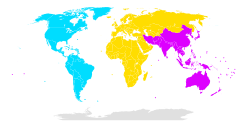The 9-centimeter band is a portion of the SHF (microwave) radio spectrum internationally allocated to amateur radio and amateur satellite use. The amateur radio band, in ITU regions 1 and 2, is between 3.300 GHz and 3.500 GHz, and it is available only on a secondary basis. The amateur satellite band is between 3.400 GHz and 3.410 GHz, and it is only available in ITU Regions 1 and 2, on a non-interference basis to other users (ITU footnote 5.282). In Germany and Israel, the band 3.400 - 3.475 GHz is also allocated to the amateur service on a secondary basis (ITU footnote 5.431).
In CEPT's "European Common Allocation Table", footnote EU17 allocates 3.40 GHz to 3.41 GHz to European amateurs on a secondary basis.
In the US, the FCC is recommending removing the amateur service from this band in order to make room for the 5G cellular system. There have been many objections to this proposal by Amateur Radio operators, including the ARRL.
History
This section needs expansion with:
|
List of notable frequencies

- 3.4001 GHz: IARU Region-1 calling frequency and Global EME center of activity
- 3.4561 GHz: IARU Region 2 calling frequency
Radio Astronomy
3.332 - 3.339 GHz and 3.3458 - 3.3525 GHz are used by radio astronomers for spectral line observations. Amateur stations voluntarily avoid using these frequencies when in geographic proximity to a radio telescope. ITU footnote 5.149 encourages all radio communications in the band to take practical steps to avoid harmful interference to radio astronomy observations in those frequency ranges.
Countries with more restricted allocation
Sweden
The Swedish Post and Telecom Authority (PTS) does not consider 3.4 GHz to be an amateur band, and has therefore auctioned it off for 5G test use. Temporary permits in the 3.400 - 3.401 GHz range are currently issued however.
Spain
The Ministerio de Asuntos Económicos y Transformación Digital does not allow 3.4 GHz to be used by amateurs. Currently this band is used by 5G services.
See also
References
- ^ "FCC Online Table of Frequency Allocations" (PDF). 47 C.F.R. Federal Communications Commission. August 13, 2015. Retrieved October 27, 2015.
-
Blondeel Timmerman, Hans (15 March 2009). "3300-3500 MHz". International Amateur Radio Union Region 1 Homepage. International Amateur Radio Union Region 1. Retrieved August 4, 2011.
EU17: In the sub-bands 3400-3410 MHz, 5660-5670 MHz, 10.36-10.37 GHz and 10.45-10.46 GHz the amateur service operates on a secondary basis. In making assignments to other services, CEPT administrations are requested wherever possible to maintain these sub-bands in such a way as to facilitate the reception of amateur emissions with minimal power flux densities.
- ^ "VHF Managers Handbook". 7. International Amateur Radio Union Region 1. January 2015. p. 48. Archived from the original (PDF) on June 17, 2018. Retrieved October 27, 2015.
- "ARRL to Argue for Continued Access to 3-GHz Spectrum as FCC Sets Comment Deadlines". Amateur Radio Relay League. 24 January 2020. Retrieved 28 February 2020.
- ^ "IARU Region 2 Band Plan" (PDF). International Amateur Radio Union Region 2. October 14, 2016. p. 13.
- "VUSHF Frequencies in Sweden V5.0" (PDF). Föreningen Sveriges Sändareamatörer (SSA). February 9, 2017. p. 25. Retrieved September 27, 2017.
| International amateur radio frequency allocations | ||||||||||||||||||||||||||||||||||||||||||||||||||||||||||||||||||||||||||||||||||||||||||||||||||||||||||||||||||||||||||||||||||||||||||||||||||||||||
|---|---|---|---|---|---|---|---|---|---|---|---|---|---|---|---|---|---|---|---|---|---|---|---|---|---|---|---|---|---|---|---|---|---|---|---|---|---|---|---|---|---|---|---|---|---|---|---|---|---|---|---|---|---|---|---|---|---|---|---|---|---|---|---|---|---|---|---|---|---|---|---|---|---|---|---|---|---|---|---|---|---|---|---|---|---|---|---|---|---|---|---|---|---|---|---|---|---|---|---|---|---|---|---|---|---|---|---|---|---|---|---|---|---|---|---|---|---|---|---|---|---|---|---|---|---|---|---|---|---|---|---|---|---|---|---|---|---|---|---|---|---|---|---|---|---|---|---|---|---|---|---|---|
| ||||||||||||||||||||||||||||||||||||||||||||||||||||||||||||||||||||||||||||||||||||||||||||||||||||||||||||||||||||||||||||||||||||||||||||||||||||||||
This article related to amateur radio is a stub. You can help Misplaced Pages by expanding it. |